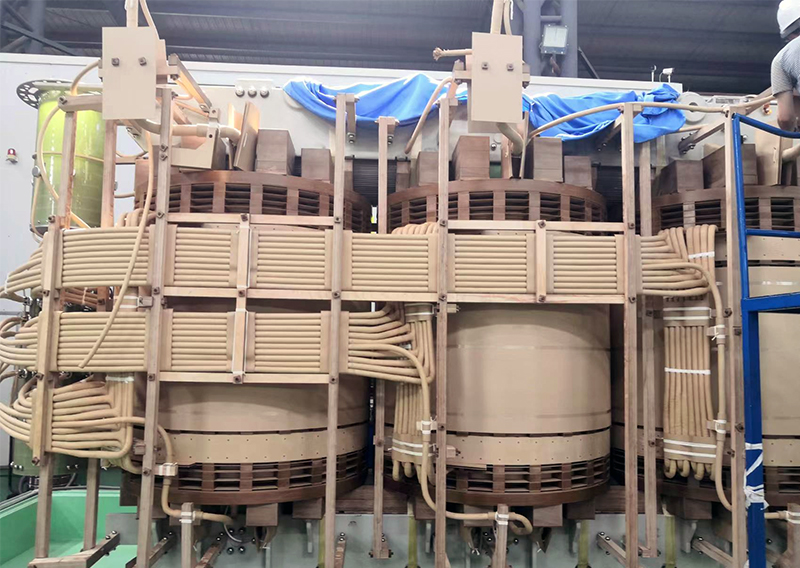- E-mail: admin@yaweitransformer.cn
- Tel: +86-18862719076
The larger the capacity of the three-phase power transformer, the higher its technical and economic indicators, but the transportation of this large transformer is inconvenient, so that its use is limited. A three-phase transformer group composed of three single-phase transformers is slightly more expensive, less efficient and occupies a larger area than a three-phase transformer of the same capacity. However, each single-phase transformer that makes up the transformer group is smaller than a full-capacity three-phase transformer in terms of size and transportation weight, so it is easy to transport and install, and each group of spare single-phase transformers is enough, and the equipment cost is lower than the use of three-phase transformers (including spare capacity). It can be seen from the above that different choices should be made according to different situations. In the case of large capacity, the transformer group composed of three single-phase transformers has the advantages of easy transportation, convenient installation and small spare capacity. In the case of medium and small capacity, the use of three-phase transformers is more economical.
Second, what are the losses of the transformer in the process of energy transfer? How to calculate its efficiency?
Because the transformer is a static electrical device that realizes power transfer according to the principle of electromagnetic induction, it only has electrical or magnetic loss in the energy transfer process, and there is no mechanical loss. When the excitation current passes through the primary winding, hysteresis loss and eddy current loss are generated in the core, which is called iron loss. It is relatively small for no-load current (that is, excitation current) and the primary winding resistance, so the loss on the primary winding resistance when the transformer is no-load is very small and can be ignored. Therefore, the iron loss of the transformer is basically equal to its no-load loss. The primary and secondary windings of the transformer have a certain resistance, and when there is a load, the current flows through these resistors, it is necessary to produce loss, which is copper loss.
The loss of these powers is proportional to the square of the current, so the copper loss of the transformer is mainly determined by the size of the load current. The size of the load current is not only related to the size of the load impedance, but also to the nature of the load (that is, the size of the power factor). It can be seen that the size of the copper loss is actually determined by the size of the load current and the power factor. The difference between the input power and the output power of the transformer is the power loss of the transformer, which is the sum of the iron loss and the copper loss.
Third, does the short-circuit voltage of the transformer affect the quality of power supply?
The voltage change rate and short-circuit voltage of transformer are the main performance indexes of transformer, which have a very important influence on the operation and power supply quality of transformer. The size of short circuit voltage plays an important role in the normal operation and accident operation of the transformer, and has a great influence on the quality of power supply. At a certain rated current, the smaller the short-circuit voltage, the smaller the short-circuit impedance. The short circuit voltage is small, which can make the load increase, the leakage impedance voltage drop of the transformer is small, and the output voltage is stable. However, from the point of view of the occurrence of short circuit accidents, it is hoped that the short circuit voltage is larger, so that the leakage impedance can be larger to limit the value of the short circuit current.
Therefore, the short-circuit voltage must have an appropriate value to ensure the normal operation and accident operation of the transformer. In addition, the short-circuit voltage for the parallel operation of the transformer is also very important, when two or several transformers in parallel operation, their short-circuit voltage must be equal. Otherwise, when the transformer with a large short-circuit voltage is fully loaded, the transformer with a small short-circuit voltage will be overloaded, and when the transformer with a small short-circuit voltage is fully loaded, the transformer with a large short-circuit voltage is in light load. In this way, the capacity of the transformer can not be reasonably matched and can not be fully utilized.
Fourth, what is the significance of temperature rise to the operation of the transformer?
Temperature rise is one of the important indexes of transformer operation, which directly affects the insulation performance of transformer. Too high temperature rise will accelerate the aging speed of insulation and shorten the life of the transformer. If the temperature rise is too low, the transformer is not fully utilized. Generally, the temperature that the insulation can withstand for a long time does not exceed 90~95 ° C, if it exceeds the allowed temperature, the service life of the insulation is reduced by half for every increase of 8 ° C. The regulations indicate that when the transformer runs continuously with no-load loss and short circuit loss equivalent to 75 ° C, the temperature rise of each part of the transformer is higher than that of the surrounding air, which shall not exceed a specific value (such as the allowable temperature rise of 65 ° C in the winding, and the allowable temperature rise of 70 ° C in the iron core), and the temperature of the surrounding cooling air naturally changes, with a maximum value of 40 ° C.
